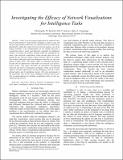| dc.contributor.author | Berardi, Christopher Walter | |
| dc.contributor.author | Solovey, Erin S. | |
| dc.contributor.author | Cummings, M. L. | |
| dc.date.accessioned | 2013-10-25T14:51:50Z | |
| dc.date.available | 2013-10-25T14:51:50Z | |
| dc.date.issued | 2013-06 | |
| dc.identifier.isbn | 978-1-4673-6213-9 | |
| dc.identifier.isbn | 978-1-4673-6214-6 | |
| dc.identifier.isbn | 978-1-4673-6212-2 | |
| dc.identifier.uri | http://hdl.handle.net/1721.1/81776 | |
| dc.description.abstract | There is an increasing requirement for advanced analytical methodologies to help military intelligence analysts cope with the growing amount of data they are saturated with on a daily basis. Specifically, within the context of terror network analysis, one of the largest problems is the transformation of raw tabular data into a visualization that is easily and effectively exploited by intelligence analysts. Currently, the primary method within the intelligence do-main is the node-link visualization, which encodes data sets by depicting the ties between nodes as lines between objects in a plane. This method, although useful, has limitations when the size and complexity of data grows. The matrix offers an alternate perspective because the two dimensions of the matrix are arrayed as an actors x actors matrix. This paper describes an experiment investigating node-link and matrix visualization techniques within social network analysis, and their effectiveness for the intelligence tasks of: 1) identifying leaders and 2) identifying clusters. The sixty participants in the experiment were all Air Force intelligence analysts and we provide recommendations for building visualization tools for this specialized group of users. | en_US |
| dc.description.sponsorship | Lincoln Laboratory | en_US |
| dc.description.sponsorship | National Science Foundation (U.S.) (Grant 1136996) | en_US |
| dc.language.iso | en_US | |
| dc.publisher | Institute of Electrical and Electronics Engineers (IEEE) | en_US |
| dc.relation.isversionof | http://dx.doi.org/10.1109/ISI.2013.6578843 | en_US |
| dc.rights | Creative Commons Attribution-Noncommercial-Share Alike 3.0 | en_US |
| dc.rights.uri | http://creativecommons.org/licenses/by-nc-sa/3.0/ | en_US |
| dc.source | MIT web domain | en_US |
| dc.title | Investigating the efficacy of network visualizations for intelligence tasks | en_US |
| dc.type | Article | en_US |
| dc.identifier.citation | Berardi, Christopher W., Erin T. Solovey, and Mary L. Cummings. “Investigating the efficacy of network visualizations for intelligence tasks.” In 2013 IEEE International Conference on Intelligence and Security Informatics, 278-283. Institute of Electrical and Electronics Engineers, 2013. | en_US |
| dc.contributor.department | Massachusetts Institute of Technology. Department of Aeronautics and Astronautics | en_US |
| dc.contributor.department | Massachusetts Institute of Technology. Humans and Automation Lab | en_US |
| dc.contributor.mitauthor | Berardi, Christopher Walter | en_US |
| dc.contributor.mitauthor | Solovey, Erin S. | en_US |
| dc.contributor.mitauthor | Cummings, M. L. | en_US |
| dc.relation.journal | Proceedings of the 2013 IEEE International Conference on Intelligence and Security Informatics | en_US |
| dc.eprint.version | Author's final manuscript | en_US |
| dc.type.uri | http://purl.org/eprint/type/ConferencePaper | en_US |
| eprint.status | http://purl.org/eprint/status/NonPeerReviewed | en_US |
| dspace.orderedauthors | Berardi, Christopher W.; Solovey, Erin T.; Cummings, Mary L. | en_US |
| dc.identifier.orcid | https://orcid.org/0000-0002-4284-272X | |
| mit.license | OPEN_ACCESS_POLICY | en_US |
| mit.metadata.status | Complete | |
